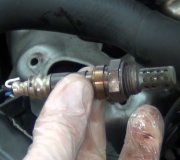I do this with the engine running. Use pieces of cardboard along the outer edges of the heads to direct spraying oil back into the heads, and start with at least a little free play in the push rods. Next, with the engine running, I like to snug all of the rocker arms just enough to quiet the clicking.
Start with the first valve, tighten the rocker arm just until you get a misfire from that valve being held open a little. Now back the adjustment off until the misfire goes away. Now count the number of turns on the adjustment and back it off until you hear that push rod start to click. Run the adjustment back down half way. That sets the adjustment so the lifter is centered in its range of adjustment.
It's best to do this with the engine warmed up. If you start with a cold engine, in the final step, run the adjustment down just a little less than half way. That will end up with the lifter centered later when it is warmed up. Typically it takes roughly 1 1/2 to 2 turns on the adjustment nut between the misfire and the clicking push rod, so in the last step, expect to tighten the adjustment just under one turn.
I should mention too that when you begin running the adjustment down, you will get a misfire with as little as a quarter turn on the adjuster. That will go away within about ten seconds as that lifter slowly bleeds down to self adjust. Keep tightening 1/8 to 1/4 turn at a time, and wait for the misfire to clear up. It's when that misfire no longer clears up is when the lifter is fully collapsed. That's when you start the back-off step.
Also, don't allow those misfires to occur for too long. When the valve is fully closed, heat is transferred from the valve face to the seat. By being held open, the valve can overheat and start to burn. That burning takes a lot longer to occur than this procedure takes. You just don't want to get to the misfire stage, then go and answer the phone.
Let me know if that works for you.
Monday, December 16th, 2024 AT 2:22 PM


